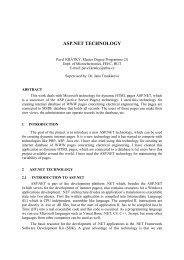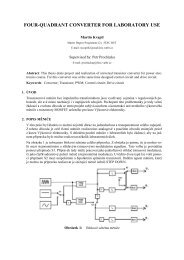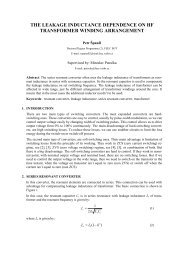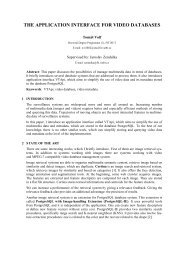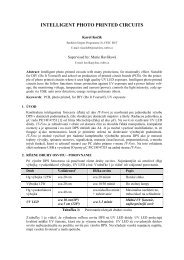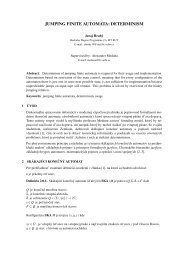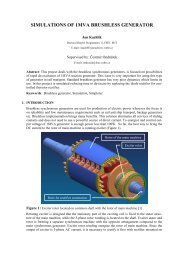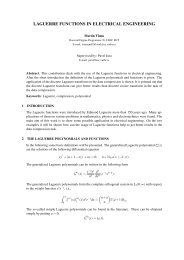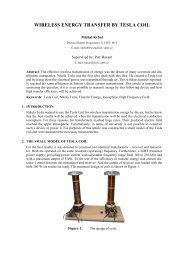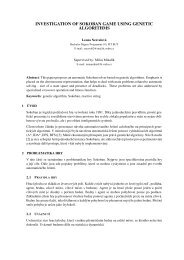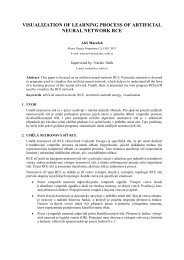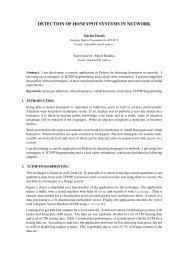DATAMINING IN DATA STREAMS
DATAMINING IN DATA STREAMS
DATAMINING IN DATA STREAMS
Create successful ePaper yourself
Turn your PDF publications into a flip-book with our unique Google optimized e-Paper software.
<strong><strong>DATA</strong>M<strong>IN</strong><strong>IN</strong>G</strong> <strong>IN</strong> <strong>DATA</strong> <strong>STREAMS</strong><br />
Jakub Malý<br />
Doctoral Degree Programme (1), FIT BUT<br />
E-mail: xmalyj07@stud.fit.vutbr.cz<br />
Supervised by: Jitka Kreslíková<br />
E-mail: kreslika@fit.vutbr.cz<br />
Abstract: Process of data mining consists from many steps. Successful and fast data mining challenges<br />
us with techniques for data reduction without substantial loss of information, structuring data<br />
by indexing methods for faster retrieving and final data mining. In this paper several final data<br />
mining algorithms are overviewed.<br />
Keywords: Data mining, Lossy counting algorithm, DSM-FI, FTP-DS, estDec<br />
1. <strong>IN</strong>TRODUCTION<br />
Data mining is process of finding relevant information in data. This relevant information can be<br />
frequent patterns. The pattern can be a set of items, subsequence, substructure. To consider pattern<br />
as frequent it must comply with condition of minimum support. There are methods for data mining<br />
in static data sets, but e.g. financial data streams – which is never ending stream of data - different<br />
approaches. This is because we cannot scan whole history of database, so we cannot easily determine<br />
which patterns are frequent.<br />
There are two approaches to overcome difficulty with determination of frequent and infrequent patterns<br />
– which frequency of occurrence can vary during the time:<br />
1. It is possible to keep track just for predefined, limited set of items.<br />
2. Or it is possible to derive approximate set of answers, which approximates the frequency of<br />
items within user defined error bound .<br />
The first approach has very limited usage because it requires the system to confine the scope of<br />
predefined patterns beforehand. The second approach is more common in data mining; therefore<br />
this chapter will cover some interesting data mining methods from this area.<br />
2. ALGHORITHMS<br />
2.1. LOSSY COUNT<strong>IN</strong>G ALGORITHM<br />
Simple but very efficient algorithm. User defines two input parameters – minimal support threshold<br />
, error bound. Incoming data stream is divided into groups of same width . Let N be the<br />
count of items seen so far. Frequency list data structure is used by this algorithm to store all items<br />
with frequency >0. For each of stored items the structure contains information about approximate<br />
frequency count f and for maximum possible error of f. The algorithm is processing groups of<br />
same length and frequency list is continuously updated. If a given item already exists in the list, its<br />
frequency count is increased. If item does not exist in list it is added into and its f value is set to default<br />
value of 1. If the new item is from bth group, we set , the maximum possible error on the<br />
frequency count of the item to be b – 1. Whenever a last item in group is processed the frequency<br />
structure list is revaluated. Let b be current group number. An item from frequency list structure is<br />
removed when condition is satisfied. Thanks to this revaluation frequency list remains
small in size and can be stored in limited computer memory. The frequency count stored for each<br />
item is true frequency of an item or an underestimate of it.<br />
Approximation ratio (or error bound) is one of the most important factors. Item from frequency<br />
structure list is deleted in case condition is satisfied for an item. stands for actual<br />
maximal frequency. Following conditions are valid , . From previous equation re-<br />
sults that maximal value of b for item to be underestimated is equal to .<br />
Features of Lossy counting algorithm<br />
- No false negatives<br />
- Result can contains false positives – but their minimal frequency still satisfies condition<br />
- Frequency of a frequent item can be underestimated by at most<br />
- Needed space for items in computer memory to handle Lossy counting algorithm should not<br />
exceed .<br />
Looking for frequent itemsets is more difficult that looking for frequent items. Number of possibilities<br />
grows exponentially with count of items in set. Processing group after group can lead to out of<br />
memory problems very soon. It is possible to process as many groups as possible (related to<br />
memory issues) to partially avoid this problem. With consideration to loading as many groups as<br />
possible to memory frequency list structure oriented on frequent itemsets can be created. In case <br />
groups can be read into computer memory following operation can be done. We update f by counting<br />
the occurrences of an itemset among the current batch of groups if this itemset already exists<br />
in frequency list structure. In case updated itemset satisfies where b stands for current<br />
group number, itemset is removed from frequency list structure. In case when itemset has frequency<br />
, and it is not currently presented in frequency list, it is inserted with where<br />
represents maximum error of f.<br />
It is very common in real applications to set to larger numbers – greater than 30. This setting has<br />
significant influence to memory consumption. The bigger the the lesser the count of stored item<br />
sets. As the count of stored itemsets rise the algorithm is slower and much greedier for free<br />
memory. Lossy counting algorithm has following limitations:<br />
- Space bound is insufficient due to frequency list structure, which can grow as far as data stream<br />
continue<br />
- Content of frequency list structure is based on all previews processed data, although user preferences<br />
can be different – he can be more interested in recent data than historical ones<br />
2.2. DSM-FI<br />
Single-pass algorithm for mining of all frequent itemsets in data streams based on a landmark windows<br />
model with defined minimum support threshold and user-defined maximal estimated<br />
support error threshold with a goal to minimize memory usage as possible<br />
(Hua-Fu, Suh-Yin, & Man-Kwan, An Efficient Algorithm for Mining Frequent Itemests over the<br />
Entire History of Data Streams).<br />
DSM-FI algorithm reads a basic window of transactions from the buffer in main memory and sorts<br />
them in lexicographical order. It constructs and maintains an in-memory prefix-tree based summary<br />
data structure called SFI-Forest (Summary Frequent Itemset Forest). It prunes the infrequent information<br />
from the current SFI-Forest. It finds the frequent itemsets from the SFI-Forest when it is<br />
needed.<br />
Algorithm to search frequent (Top Down Frequent Itemset selection) for identifying frequent items<br />
from SFI-Forest can be found as part of (Hua-Fu, Man-Kwan, & Suh-Yin, DSM-FI: An efficient<br />
algorithm fo mining frequent itemsets in data streams, 2007) paper.
Comparision to Lossy counting alghoritm (LCA)<br />
In practice, execution of DSM-FI is steadier and shorter than LCA. Memory usage of DSM-FI is<br />
more stable. This is mainly because DSM-FI does not need to enumerate all subsets of each incoming<br />
transaction. The amount of all subsets is an enormous exponential number for long transaction.<br />
Hence, it shows that DSM-FI is more suitable for mining long frequent itemsets in data streams<br />
(Hua-Fu, Suh-Yin, & Man-Kwan, An Efficient Algorithm for Mining Frequent Itemests over the<br />
Entire History of Data Streams).<br />
2.3. FTP-DS<br />
FTP-DS (Frequent Temporal Patterns of Data Streams) has two major features. The first one is one<br />
scan for online statistics collection and regression-based compact pattern representation. This information<br />
is used for better addressing time and the space constraints in a data stream environment.<br />
To attain the feature of one data scan, the occurrence frequency of a temporal pattern is first defined<br />
in accordance with the time constraint of sliding windows. For frequency counting purpose<br />
the data segmentation and pattern growth scenarios are explored. In next step FTP-DS scans online<br />
transaction flows and generates candidate frequent patterns as data arrives. Thanks to downward<br />
closure property, longer patterns are gradually formed from their subsets as time advances. The result<br />
of this is that frequent patterns are incrementally discovered and recorded by only one database<br />
scan. The second major feature of FTP-DS is based on the regression-based compact pattern representation<br />
which is designed to address the space constraint of a data stream environment. Data<br />
stream of incoming data is segmented. Regression process is used for identifying each segment of a<br />
time series. Regression analysis is used to capture the trends of frequent patterns. Algorithm works<br />
with implements segmentation tuning which aims to reduce the error of constructing fit lines. Segmentation<br />
tuning can result in more precise segments, which leads to more accurate mining results.<br />
The second improving technique is the segment relaxation which refers to the adjustment of segment<br />
periods along the time dimension in accordance with their corresponding importance to save<br />
the storage required. By experimental tests it was proved that algorithm FTP-DS can meet both<br />
time and space limitations in a data stream environment (Wei-Guang, Ming-Syan, & Philip S.,<br />
2003).<br />
Algorithm FTP-DS: Frequent Temporal Patterns of Data Streams can be found as part of (Wei-<br />
Guang, Ming-Syan, & Philip S., 2003) paper.<br />
2.4. ESTDEC<br />
Algorithm estDec is designed to work with most recent data, which has the biggest impact on itemset<br />
frequency. Algorithm examines each transaction in a data stream one by one without any candidate<br />
generation and keeps track of the occurrence count of an itemset in the transactions generated<br />
so far by a prefix tree structure. estDec maintains a lattice for recording the potentially frequent<br />
itemsets and their counts, and updates the lattice for each new transaction correspondingly. By recording<br />
additional information for each itemset p, the time-point of the most recent transaction that<br />
contains p, the algorithm only needs to update the counts for the itemsets which are the subsets of<br />
newly arrived transactions. It reduces their counts using the constant factor d and then increases<br />
them by one (Mala & Dhanaseelan, 2011).<br />
Algorithm estDec can be found as part of (Joong Hyuk & Won Suk, 2003) paper.<br />
3. FUTURE RESEARCH<br />
In future I will try to learn more about other algorithms for more accurate selection of set of algorithms<br />
for my next research work related to price stream indication system.
As a part of my future research, I would like to test the efficiency of alternative algorithms, namely<br />
IDSM-MFI [6]. Live data streams data mining is generally posing more challenges for the data<br />
processing subsystems than mining static database data set collections because of the continuous<br />
nature of the streaming data. IDSM-MFI algorithm implements a synopsis data structure concept<br />
which stores the transactions progressively found in the data streams that are being mined. IDSM-<br />
MFI algorithm uses a top-bottom and bottom-top models to construct the set of all maximum frequent<br />
itemsets in landmark windows that are contained in the examined data stream. The data mining<br />
results can be displayed in real time based on the operator's preferences and expressed thresholds.<br />
The creators of IDSM-MFI algorithm claim that their theoretical analysis and experimental<br />
results prove the efficiency of this algorithm, as well as its robustness and scalability for mining the<br />
data set for all maximum frequent itemsets in the history of the examined data stream.<br />
I would also like to analyse the Probabilistic Lossy Counting (PLC) algorithm, introduced by the<br />
authors Dimitropoulos, Hurley and Kind from IBM Zurich Research Lab. PLC algorithm focuses<br />
on processing real time data traffic flows in network management applications in order to pin point<br />
the largest flows. The central issue related to finding these resource-consuming network flows is<br />
known as the “heavy-hitter problem”. Numerous attempts at solving the heavy-hitter problem have<br />
been made in the past years. The suggested Probabilistic lossy counting algorithm enhances the<br />
above discussed Lossy counting algorithm and is geared towards the applications in the domain of<br />
network traffic to uncover the heavy-hitters. The accuracy of PLC derives more from probabilistic<br />
rather than deterministic guarantees. The main advantage of PLC over LC is seen in lower memory<br />
consumption. Moreover, PLC generates lower rate of false positives compared to LC as well as low<br />
estimation error, even though the estimation error is slightly higher than the same measure for LC.<br />
4. CONCLUSION<br />
Enormous effort is invested into development of new data mining algorithms, which are faster, less<br />
greedy for computer resources and can successfully filter insignificant information. Data streams<br />
are a computational challenge to data mining problems because of the additional algorithmic constraints<br />
created by the large volume of data.<br />
ACKNOWLEDGEMENT<br />
This work was partially supported by the BUT FIT grant FIT-S-11-1 and the research plan<br />
MSM0021630528.<br />
REFERENCES<br />
[1] Hua-Fu, Li, Suh-Yin, Lee a Man-Kwan, Shan: An Efficient Algorithm for Mining Frequent<br />
Itemests over the Entire History of Data Streams, National Chiao-Tung University, Taiwan,<br />
[online, cit. 2012-03-05],<br />
WWW: <br />
[2] Hua-Fu, Li, Man-Kwan, Shan a Suh-Yin, Lee: DSM-FI: An efficient algorithm for mining frequent<br />
itemsets in data streams, London: Springer-Verlag, 2007,<br />
[online, cit. 2012-03-05],<br />
WWW: <br />
[3] Wei-Guang, Teng, Ming-Syan, Chen a Philip S., Yu: A Regression-Based Temporal Pattern<br />
Mining Scheme for Data Streams, National Taiwan University, Taiwan, 2003,<br />
[online, cit. 2012-03-05],<br />
WWW: <br />
[4] Mala, A. a Dhanaseelan, F.Ramesh: Data streamming algorithms - a review of issues and existing<br />
approaches, KNSK College of Engineering, Nagercoil, India, 2011,
[online, cit. 2012-03-05],<br />
WWW: <br />
[5] Joong Hyuk, Chang a Won Suk, Lee: Finding Recent Frequent Itemsets Adaptively over<br />
Online Data Streams, Yonsei University, Seoul, Korea, 2003,<br />
[online, cit. 2012-03-05],<br />
WWW: <br />
[6] Yinmin Mao, Hong Li, Lumin Yang, Zhigang Chen, Lixin Liu, "A Mining Maximal Frequent<br />
Itemsets over the Entire History of Data Streams," dbta, pp.413-417, 2009 First International<br />
Workshop on Database Technology and Applications, 2009



